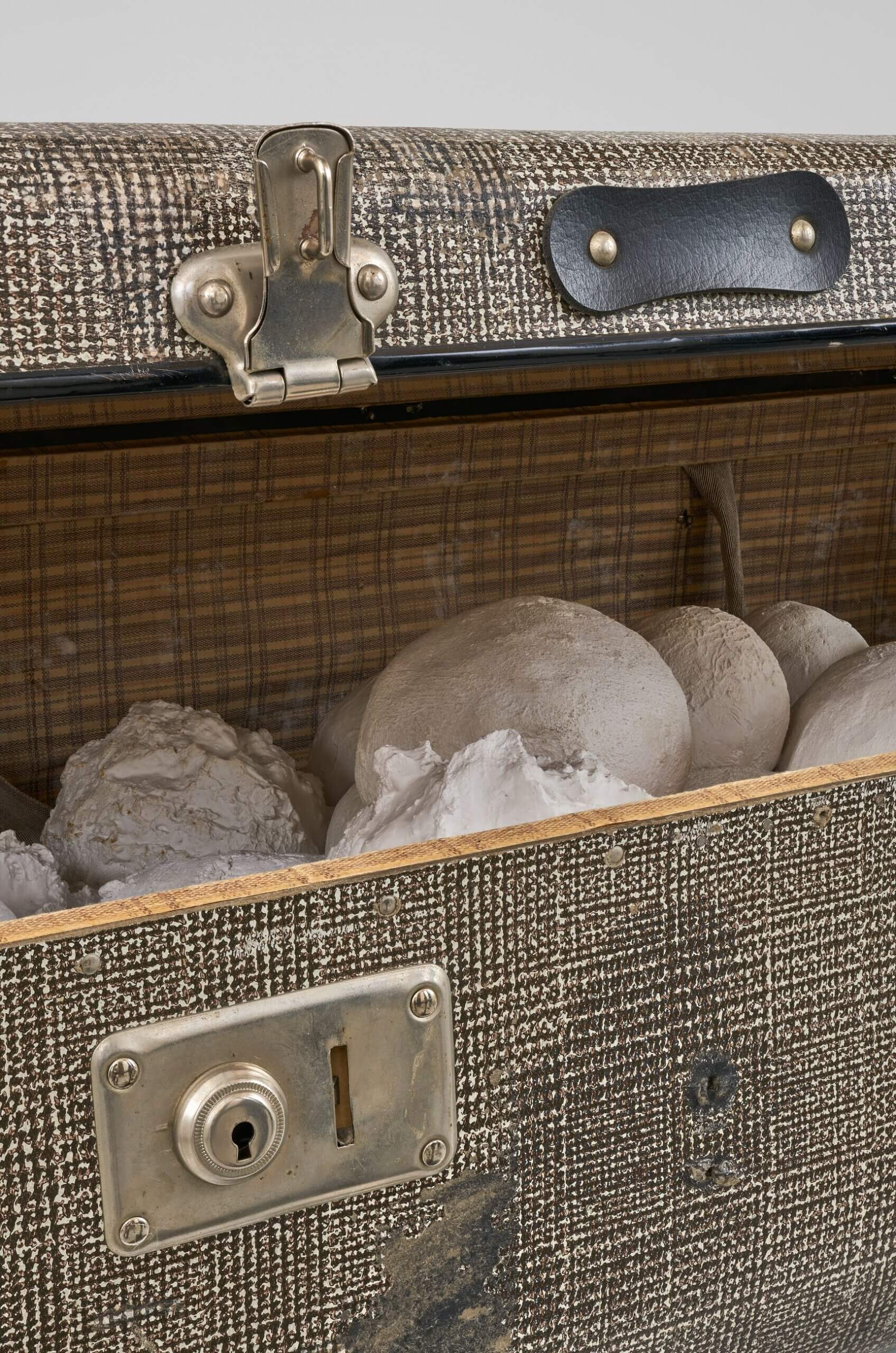
Marcel Broodthaers
Sculpture
Sculpture
1974 Cardboard suitcase, paint, and white plaster balls 20.5 x 80 x 52.7 cm / 8 1/8 x 31 1/2 x 20 3/4 in
Enigmatic and confronting, ‘Sculpture’ (1974) masterfully captures Broodthaers’s examination of the relationship between language and art, which informed the artist’s short yet prolific practice. In ‘Sculpture’, white plaster spheres of varying sizes fill a threadbare cardboard suitcase. The spheres reflect the ragged exterior of the suitcase; varying in texture, their uneven surfaces reveal a range of folds and creases, with some seemingly baring the trace of the artist’s hand.
Sculpture
Reminiscent of eggshells, which are often prominent subjects in Broodthaers’s work, there is a certain emptiness and fragility to them. Absent of colour, ‘Sculpture’ is monotone in appearance, calling attention to the physical nature of the work and its material qualities. On top of the suitcase, the word ‘SCULPTURE’ is written in a traditional, capital letter serif font. Through this act of classification, Broodthaers takes an ordinary utilitarian object – a suitcase – and deprives it of its function, redefining it as an art object (in this case, as sculpture).
Created in 1974, ‘Sculpture’ underscores the influence that Broodthaers’s predecessors had on his development as an artist; he had a deep connection with the art and literature of the past, stating: ‘I have just followed the footprints left in the artistic sands by René Magritte and Marcel Duchamp.’ [1] Accordingly, ‘Sculpture’ directly calls to mind the semiotics at play in Duchamp’s ‘Fountain’ (1917) and Magritte’s ‘Ceci n’est pas une pipe’ (1929), which similarly sought to disrupt fixed word-object associations. Here, Broodthaers builds on Magritte’s statement that ‘An object is not so wedded to its name that one cannot find another which suits better’ [2]. Through an act of labelling, Magritte ‘sought to give [objects] a freedom from conventional association’, as Broodthaers does in ‘Sculpture’. [3] Further reflecting on the profound influence that Magritte had on his work, Broodthaers notes: ‘I was haunted by a certain painting by Magritte, the one in which words figure. With Magritte, you have a contradiction between the painted word and the painted, a subversion of the sign of language and that of painting so as to restriction the notion of the subject.’ [4] Broodthaers’s fascination with word-object associations is deeply rooted in his literary background as a poet. Incidentally, Broodthaers transitioned to a career in art at the age of forty. As an opening statement for his first exhibition in 1964 at Galerie Saint Laurent in Brussels, he expressively stated: ‘I, too, wondered whether I could not sell something and succeed in life .... the idea of inventing something insincere crossed my mind and I set to work right away.’ [5] Throughout his oeuvre, his poetic aesthetic was always simple yet provocative, which is deeply evident in ‘Sculpture’. His practice often involved assembling found materials – such as mussels, eggshells, suitcases and discarded household goods – which communicated simplicity and poverty in the face of big business, mass production and cultural homogeneity. Broodthaers frequently revisited these visual motifs, and through their repetition, he achieved a visual rhetoric that was uniquely and recognisably his own. For example, in ‘Sculpture’, Broodthaers utilises a suitcase as a treasure trove of sorts, containing unconventional and mysterious items, in a similar fashion to his seminal works ‘La Valise Belge (The Belgian Suitcase)’ (1964) and ‘Casserole et moules fermées (Casserole and Closed Mussels)’ (1964). As a whole, Broodthaers’s aesthetic is often tongue-in-cheek and self-mocking, crafting a unique visual rhetoric through layers of metaphor and poetic thought. Ultimately, his works are playfully 'insincere' because, it is only fiction that ‘enables us to grasp reality.’ [6] It is this wit and enigmatic nature of Broodthaers’s work that defined his illustrious (albeit short) twelve-year career, establishing himself as one of the most original artists of his day and as an iconic figure within the history of Conceptual art.
[1] Marge Goldwater, Michael Compton, Douglas Crimp, 'Marcel Broodthaers', Minneapolis MN: Walker Art Center, 1989, p. 32. [2] ReneMagrittequotedinDavidSylvester,‘Magritte’,HoustonTX:MenilFoundation,1992,p.210. [3] DeborahSchultz,‘MarcelBroodthaers:StrategyandDialogue,’NewYorkNY:PeterLang,2007,p.139. [4] Marcel Broodthaers, ‘Ten Thousand Francs Reward’, Cambridge MA: MIT Press, in: October, vol. 42, 1987, p. 39. [5] MarcelBroodthaersquotedinChristopheCherixandManuelBorja-Villel,‘MarcelBroodthaers,’NewYorkNY:MuseumofModernArt,2016, p. 76. [6] MargeGoldwater,MichaelCompton,DouglasCrimp,'MarcelBroodthaers',MinneapolisMN:WalkerArtCenter,1989,p.71.

Celebrating Basel Basel
In 1974, Marcel Broodthaers set up the exhibition in his Décors series ‘Éloge du Sujet (Eulogy of the Subject)’ at the Kunstmuseum Basel. These multi-disciplinary, immersive installations often displayed examples of his past work unified with objects borrowed for the occasion.






